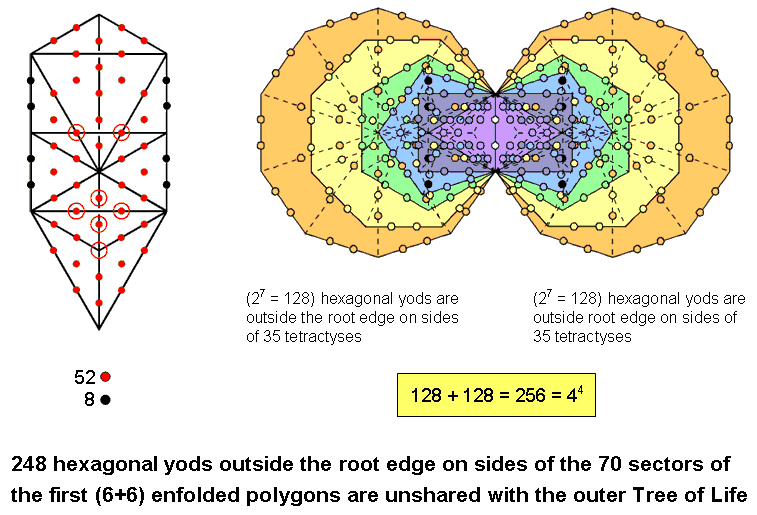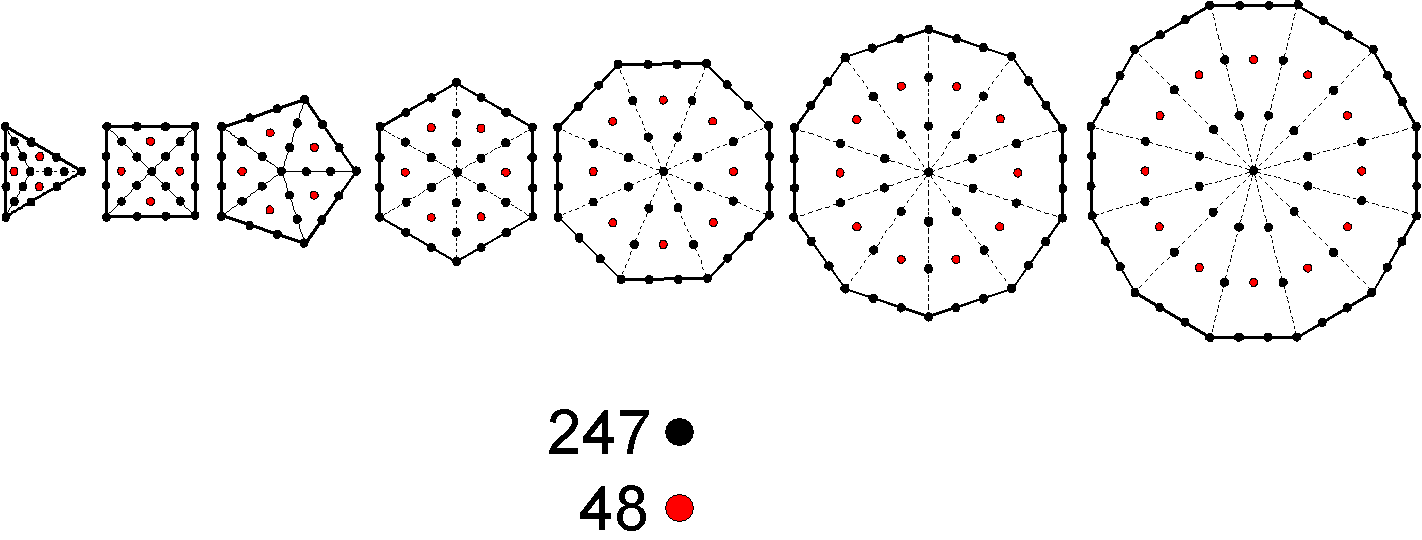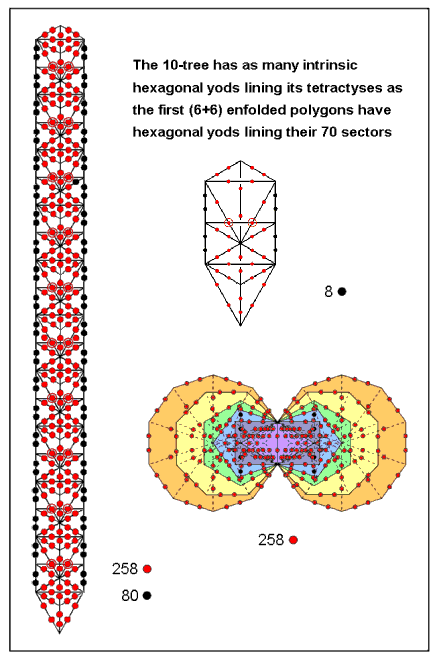
| << Previous 1... 33 34 [35] 36 37 ...50 Next >> |
Embodiment of the dimension 248 of E8 in the first (6+6) enfolded polygons of the inner Tree of Life

The (7+7) enfolded polygons have 444 hexagonal yods when the 94 sectors are tetractyses (see here). (444−94=350) hexagonal yods line their sides. The dodecagon has 48 such yods, so that the pair of dodecagons have (46+46=92) such yods outside the two white hexagonal yods in the root edge. (350−92=258) hexagonal yods line the 129 sides of the (35+35) sectors of the first (6+6) enfolded polygons, where 129 is the number value of YAHWEH SABAOTH, the Godname of Netzach.
Constructed from 16 tetractyses, the outer Tree of Life has 60 hexagonal yods. Four of these (shown as black yods in the diagram opposite) lie on the Pillar of Mercy and four (also shown as black yods) lie on the Pillar of Judgement. They coincide with similarly coloured hexagonal yods on sides of sectors of the pair of hexagons in the (7+7) enfolded polygons. This leaves 52 red hexagonal yods that are intrinsic to the outer Tree of Life in the sense that they are unshared with its inner form. The number of hexagonal yods in the superposed outer & inner Trees of Life = 52 + 258 = 310 = 31×10, where 31 is the number value of EL, the Godname of Chesed above Netzach. 310 is the 155th even integer, where 155 is the number value of ADONAI MELEKH, the complete Godname of Malkuth.
Outside the root edge of the first (6+6) enfolded polygons are (258−2=256) hexagonal yods lining their 70 sectors. As 256 = 44, this is a beautiful example of how the Tetrad expresses properties of holistic systems. (27=128) hexagonal yods outside the root edge line the 64 (=43) sides of each set of 35 sectors. Four of these in each set are shared with the outer Tree of Life, leaving 124 hexagonal yods that line 62 sides of 35 tetractyses. (2×124=248) hexagonal yods line (2×62=124) sides of the 70 sectors of the first (6+6) enfolded polygons outside their root edge. This is the dimension of E8, the rank-8 exceptional Lie group at the heart of superstring theory. Each of the 248 hexagonal yods denotes a root of E8. The first (6+6) polygons constitute a holistic structure (see Article 4 for how the Godnames prescribe their geometry). This is illustrated by their embodiment of the number 70, which is a parameter of the Tree of Life, being the number of yods that it contains, and by the 35:35 division of their 70 sectors, which parallels the way in which the 70 yods consist of 35 yods in the trunk of the Tree of Life and 35 yods in its branches (see previous page for definitions of the terms 'trunk' & 'branches'). Whatever the holistic structure, it always displays in analogous ways the Tree of Life parameters discussed in The holistic pattern, as well as their various divisions. The latter property refutes the skeptic's accusation that some part of a geometrical object can always be cherry-picked which (according to him) embodies simply by accident a scientifically significant number such as 248. If this really were the case, it is very improbable that these divisions (in this case, the 35:35 division) would also by coincidence accompany the contrived selection. Different holistic structures are manifestations of the same set of parameters and their divisions, so that mere cherry-picking could not guarantee that the patterns between certain numbers would appear as well as the holistic parameters themselves.
The first (6+6) enfolded polygons have 50 corners, where 50 is the number of ELOHIM, the Godname of Binah. Four of these are centres of the pair of hexagons and the pair of decagons, leaving eight other centres, so that their sectors have (50+8=58) corners. Each set of six enfolded polygons has 35 sectors with 64 sides outside the root edge, that is, 65 including the latter. This is how ADONAI with number value 65 prescribes each set. The (35+35=70) sectors in both sets of polygons have (64+1+64=129) sides. They comprise (50+8+129+70=257) corners, sides & triangles. 257 is the 55th prime number, where 55 is the sum of the first 10 integers:
|
1 |
||||
| 2 | 3 | |||
| 55 = |
4 |
5 |
6 |
|
| 7 | 8 | 9 | 10 . |
This shows how the Decad determines the geometrical composition of this holistic set of polygons. 55 is the fourth Kaprekar number. When an n-digit Kaprekar number is squared and the right-hand n digits are added to the left-hand n or n − 1 digits, the result is the original number. In the case of 55, 552 = 3025 and 25 + 30 = 55. In mathematics, Fermat numbers are numbers of the form Fn = 22^n + 1. The number 257 (=22^4 + 1) is the fourth Fermat number. It is also the fourth Fermat prime number. These two properties are striking illustrations of the Tetrad Principle formulated in Article 1 because both 55 (the number of corners of the 48 sectors of the seven separate polygons of the inner Tree of Life) and 257 are not only parameters of geometrical objects that are holistic but also the fourth members of two classes of numbers. (Only one number larger than 257 is known to be a Fermat prime. As of 2010, it is known that Fn is composite for 5≤n≤32. See here).
Each subset of six polygons contains 127 geometrical elements on either side of the root edge. As 127 is the 31st prime number, it is prescribed by EL ("God"), the Godname of Chesed with number value 31. They contain (58+129=187) corners & sides, where 187 is the number value of Auphanim, the Order of Angels assigned to Chokmah. 184 corners & sides are outside the root edge. Five of the 92 corners & sides outside the root edge of each set of six enfolded polygons belong to a side pillar of the outer Tree of Life. 87 corners & sides outside the root edge are intrinsic to each set. 87 is the number value of Levanah, the Mundane Chakra of Yesod. Including the root edge, each set has 90 intrinsic corners & sides. This number is another holistic parameter, being the sum of the 10 numbers of Plato's Lambda Tetractys (see here). It is further demonstration that the first six enfolded polygons constitute sacred geometry.
Encoding of the human skeleton
The table below shows the geometrical composition of the outer Tree of Life and the first (6+6) enfolded polygons
when superposed on each other:
| Outer Tree |
1st (6+6) enfolded polygons |
||||||
| Triangles | Squares | Pentagons | Hexagons | Octagons |
Decagons |
||
| Corners | 10 | 2 | 6 | 8 | 4 | 14 | 16 |
| Sides | 22 | 10 | 14 | 18 | 14 | 30 | 38 |
| Triangles | 16 | 6 | 8 | 10 | 10 | 16 | 20 |
| Total | 48 | 18 | 28 | 36 | 28 | 60 | 74 |
Entries for the polygons are the numbers of geometrical elements outside the root edge of each pair
of polygons. The Tree of Life contains 16 triangles with 10 corners and 22 sides, i.e.,
48 geometrical elements. Six corners and four sides of triangles in the Tree of Life are
shared with the first (6+6) enfolded polygons, so that four corners, 18 sides & 16 triangles, i.e., 38
geometrical elements, are unshared with them. Superposed, the outer Tree of Life and the first (6+6) enfolded
polygons contain (257+38=295) geometrical elements. Their (70+16=86) triangles have (58+4=62)
corners and (129+18=147) sides. Outside the root edge are (62−2=60) corners and
(147−1=146) sides, i.e., 206 corners & sides. This is the number of bones in the adult human
skeleton. The existence of this number is not a coincidence, for it is a parameter of
all sacred geometries that embody the universal blueprint (see Human skeleton). The first (5+5)
enfolded polygons have 50 sectors with 34 corners & 86 sides outside their root edge.
The two decagons and the outer Tree have 86 corners & sides. Hence, there is a 34:86:86 division in the
geometrical composition of the superposed Tree of Life and the first (6+6) enfolded polygons. In the human
skeleton, its counterpart are the 34 bones that occur singly in the axial skeleton and the 86
pairs of bones in the axial and appendicular skeletons (see here).
Of the 257 geometrical elements in the first (6+6) enfolded polygons, five elements (three corners & two sides) make up each side pillar. The 295 geometrical elements in the superposed outer Tree and the first (6+6) enfolded polygons, therefore, consist of the 48 elements making up the former and (257−5−5=247) elements that are intrinsic to the latter. This 48:247 division appears in the seven separate polygons as the 48 hexagonal yods at the centres of their 48 tetractys sectors and as the 247 yods lining the sides of the latter:

In terms of the correspondence between the Tree of Life and the tetractys, the hexagonal yod at the centre of the latter symbolizes Malkuth, the outer, physical form of the Tree. So it is apt that the number 48 is the number of bits of information that determine its geometrical form. Of the 295 geometrical elements (62 corners, 147 sides & 86 triangles) belonging to the outer Tree and the first (6+6) enfolded polygons, ten (six corners & four sides) are shared, leaving 285 unshared elements (56 corners, 143 sides & 86 triangles). 282 of these elements (54 corners, 142 sides & 86 triangles) are outside the root edge, where 282 is the number value of Aralim, the Order of Angels assigned to Binah. 38 unshared elements (four corners, 18 sides & 16 triangles) belong to the Tree of Life and 244 unshared elements (50 corners, 124 sides & 70 triangles) belong to the first (6+6) enfolded polygons. ELOHIM, the Godname of Binah with number value 50, prescribes the 50 corners of the first (6+6) enfolded polygons outside their root edge that are intrinsic to them. They have 120 intrinsic corners & triangles outside their root edge, where
120 = 22 + 42 + 62 + 82,
and 194 intrinsic sides & triangles, where 194 is the number value of Tzadekh, the Mundane Chakra of Chesed. The number 120 is a parameter of holistic systems, e.g., it is the number of yods on the boundaries of the seven enfolded polygons (see here).
Encoding of the 10-tree in the first (6+6) enfolded
polygons
The n-tree is the lowest n Trees of any set of overlapping Trees of Life. It has (16n+9) Paths. They are the sides
of (12n+7) triangles. When the latter are turned into tetractyses, the number of hexagonal yods lining their sides
= 2×(16n+9) = (32n+18) hexagonal yods. Eight hexagonal yods in each Tree lie on the two side pillars (indicated in
the diagram above as black yods). They coincide with the hexagonal yods on four vertical internal sides of four
tetractyses in the two hexagons of the inner form of each Tree, so that 8n hexagonal yods of the n-tree are shared
with the 14n polygons making up its inner form. The n-tree has (32n+18−8n=24n+18) hexagonal yods on sides of its
(12n+7) tetractyses that are intrinsic to it. None of them are hexagonal yods that belong also to the inner form of
the n-tree.
 In the 10-tree, 80 hexagonal yods are shared with the
140 polygons of its inner form, leaving 258 intrinsic hexagonal yods on the 169 sides of
the 127 tetractyses. As found above, 258 hexagonal yods line the 129 sides of the 70
tetractyses making up the first (6+6) enfolded polygons. The latter, therefore, embodies the number of
hexagonal yods on sides of tetractyses in the 10-tree that are not shared with the 12 polygons. This encoding
of a property of the 10-tree in the first (6+6) enfolded polygons is remarkable but not unexpected, for, being
holistic structures, they have analogous properties that are prescribed by the Godnames. For example, the
10-tree has 65 SLs (see here) and (as we found earlier) the 35 sectors of the first six enfolded
polygons have 65 sides, where 65 is the number of ADONAI, the
Godname of Malkuth.
In the 10-tree, 80 hexagonal yods are shared with the
140 polygons of its inner form, leaving 258 intrinsic hexagonal yods on the 169 sides of
the 127 tetractyses. As found above, 258 hexagonal yods line the 129 sides of the 70
tetractyses making up the first (6+6) enfolded polygons. The latter, therefore, embodies the number of
hexagonal yods on sides of tetractyses in the 10-tree that are not shared with the 12 polygons. This encoding
of a property of the 10-tree in the first (6+6) enfolded polygons is remarkable but not unexpected, for, being
holistic structures, they have analogous properties that are prescribed by the Godnames. For example, the
10-tree has 65 SLs (see here) and (as we found earlier) the 35 sectors of the first six enfolded
polygons have 65 sides, where 65 is the number of ADONAI, the
Godname of Malkuth.
This property is discussed also here. The significance of the 10-tree is that it maps the ten dimensions of superstring space-time and encodes the structural parameter 1680 of each 10-dimensional whorl of the subquark state of the E8×E8 heterotic superstring (see here), as well as the dimension 496 of E8×E8 (see here). The significance of the first (6+6) enfolded polygons is that, enfolded in the 10-tree and constructed from tetractyses, their shape-forming boundaries have 1680 yods (see here), so that they encode the oscillatory form of each whorl, which is a helix composed of 1680 circular turns.
| << Previous 1... 33 34 [35] 36 37 ...50 Next >> |